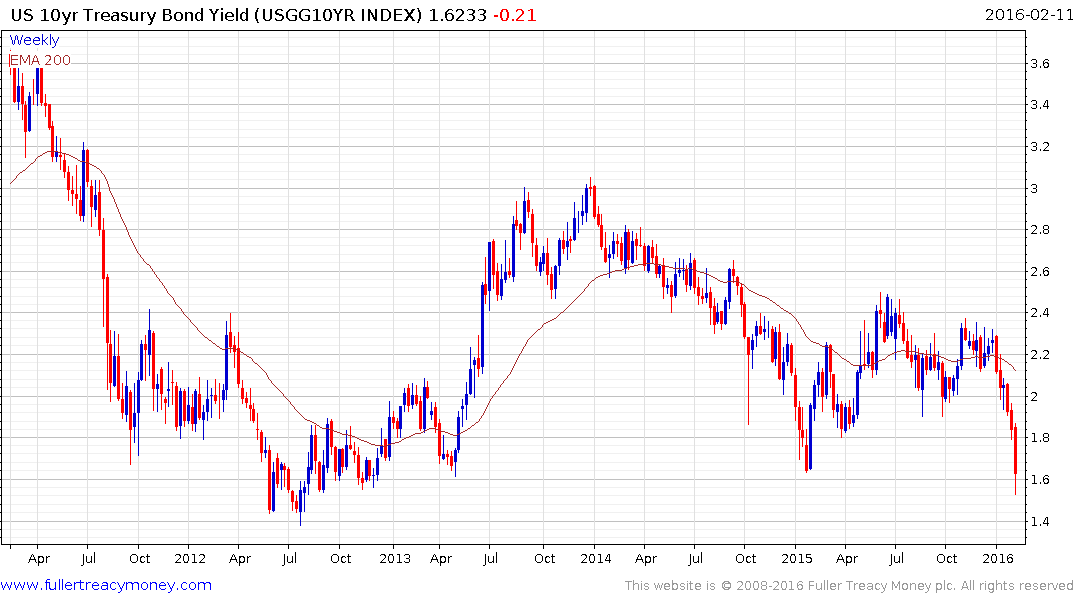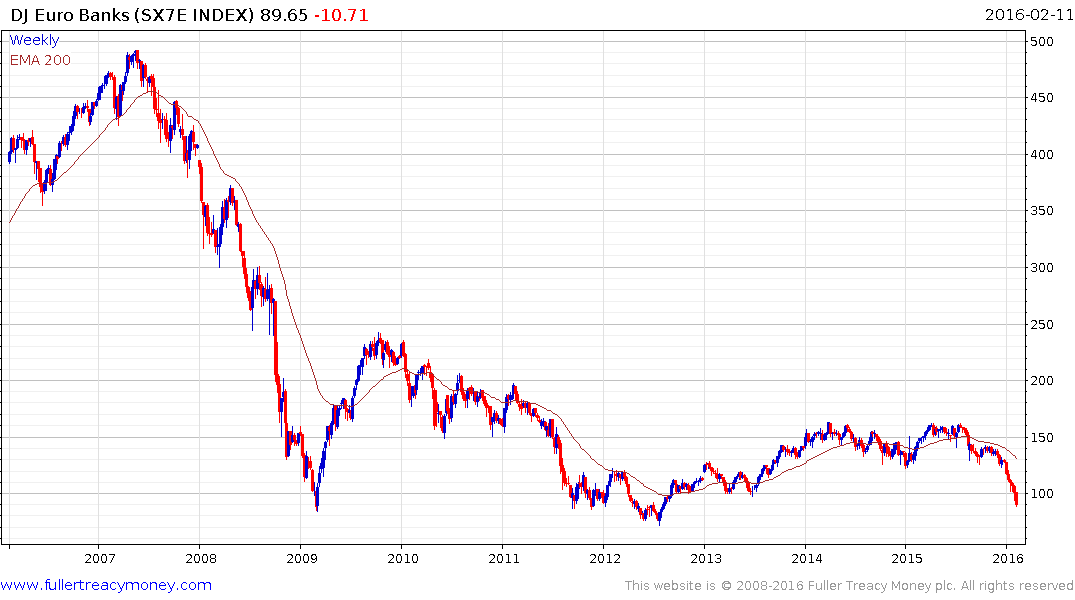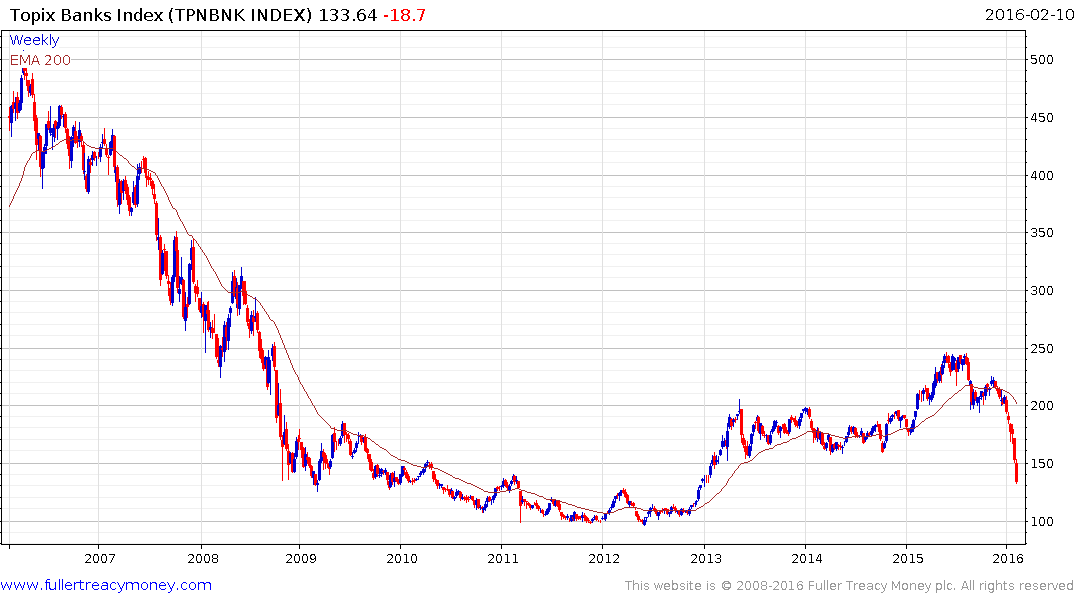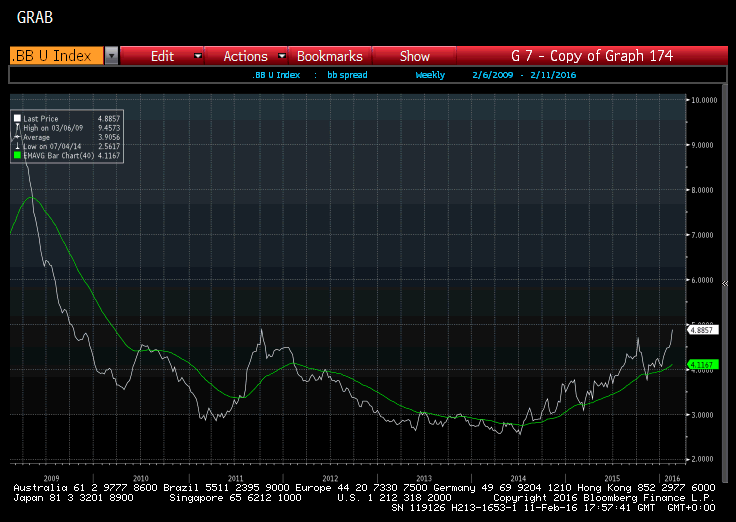A Dangerous Shift
Thanks to a subscriber for this characteristically bearish report by Gerard Minack which may be of interest. Here is a section:
The second corrosive factor for markets is the downgrading of perceived central bank potency. There are several recent hints of this decline. Mario Draghi’s ‘whatever it takes’ comment in 2012 was, in my view, the single most important central bank action of the past 5 years. However, European bank stocks – a principal beneficiary of ‘whatever it takes’ – have now almost given up all their ‘whatever it takes’ gains, despite recent ‘whatever it takes with steroids’ comments from Mr. Draghi (Exhibit 5).
Likewise, the Bank of Japan’s bazooka now seems to be firing blanks. The yen strengthened and equities fell after the cash rate was cut below zero – the opposite of what was presumably expected.
Most importantly, perceptions of the Federal Reserve also appear to be changing. Markets have never priced the Fed’s dot-plot rate guidance. More tellingly, in my view, the market is now pricing a non-trivial chance that the Fed will have to completely reverse course. Current pricing of Euro-dollar futures and options now implies a reasonable chance of zero or negative rates ahead (Exhibit 6).
Medium-term inflation expectations are my crude measure of central bank credibility. Exhibit 7 shows the 5 year-5 year forward breakeven inflation rates for Europe and the US (an implicit forecast of inflation 6-10 years from now). These measures have been falling for 18 months. Markets are increasingly of the view that central banks will not be able to achieve their key policy aim: returning inflation to normal levels.
My medium-term view is that central banks will not be able to overcome the forces of disinflation. I didn’t expect markets to agree with that until the next recession. However, if that is what is happening now, then this will be a more difficult year than I had been expecting.
Here is a link to the full report.
The IMF paper I posted on Tuesday highlighting a mechanism for introducing negative interest rates by reducing the attractiveness of paper money should not be taken lightly. It is perhaps the most relevant example of the lengths to which central banks are willing to go to achieve their goals. Since Janet Yellen refused to rule out the potential for the USA to adopt a negative interest policy in future we can conclude the ECB and BoJ are not the only central banks considering the tool.
Japanese government bonds (JGBs) are at negative yields out to 7-year maturities. German government bond yields are negative out to 8-year maturities. Switzerland has negative yields out to 15-year maturities. Even Ireland has negative yields out to 4-year maturities. This is an extreme situation by any measure.

These are accelerating trends which as we know from The Chart Seminar is a trend ending, but of undetermined duration. US 10-year yields have fallen persistently since the beginning of the year and tested the psychological 1.5% area today before rebounding. Oil prices are still weak, commodities prices generally are still searching for a low and China is still on a holiday with no one knowing how the market will open on Monday. Gold has finally broken its lengthy medium-term downtrend. Nevertheless, Treasury yields represent an accelerating trend and potential for a reversionary rally that would unwind the short-term overbought condition in prices is looking increasingly likely.
The problem for banks is that Basel III, which has been implemented over the last couple of years, raises the threshold for what they can hold to meet capital adequacy standards. They have had to hold increasingly large stockpiles of capital which has hindered their ability to lend. Concurrently record low interest rates have meant they are getting less for the money they do lend. The prospect of negative interest rates is particularly bad news, as Eurozone banks are already experiencing, because not only do they have to hold more capital but they have to pay the ECB for the privilege. That’s at least part of the reason for the commonality in how bank shares are underperforming globally.

The DJ Euro STOXX Banks Index is also accelerating lower and has yet to signal any respite in selling pressure as it falls towards the 2012 low. Nevertheless it is almost 50% overextended relative to the trend mean so potential for a reversionary rally is increasing. Beyond that, banks are unlikely to be a leading sector for the foreseeable future because of the factor discussed above.

Japanese Banks are crashing lower and are down almost 50% since November. The first clear upward dynamic is likely to signal short covering but this represents massive technical deterioration and a lengthy period of support building will be required to help rebuild confidence despite reasonably attractive valuations.

BB US$ Corporate Spreads rallied to test the 2011 peak today and while somewhat overbought in the short-term, a sustained move below 400 basis points would be required to question medium-term scope for additional expansion. This is perhaps the greatest threat to the market right now because the ability of companies to fund dividend increases and share buybacks is tied to raising funds at attractive rates. The importance of companies being able to fund their operations in the bond markets is all the more important because banks are under such stress. Covenant light and contingent convertible issuance has surged to new highs over the last couple of years and there is a prospect that this will become a problem as funding mechanisms become more expensive.


